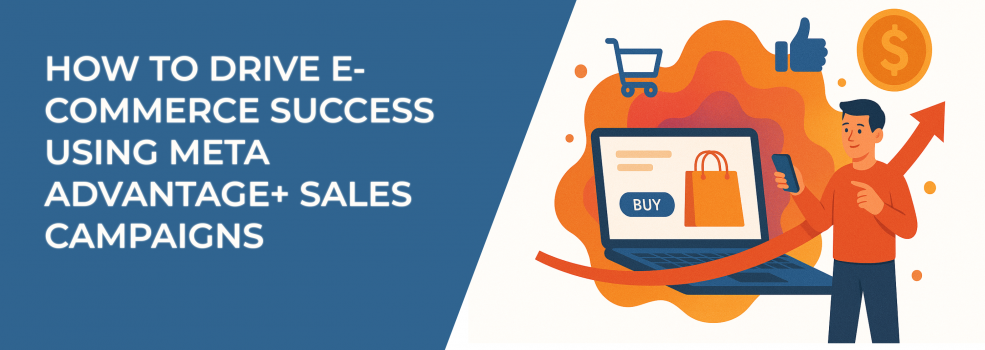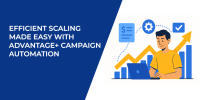Meta’s advertising platform is evolving rapidly. If you’ve been running campaigns on Facebook or Instagram, you’ve likely noticed that traditional manual setups can feel increasingly inefficient. Advertisers looking to streamline operations and improve performance are turning toward a more intelligent solution — Meta’s Advantage+ Sales Campaigns.
So how can you leverage them to drive measurable results without relinquishing full control?
In this article, we’ll explore what’s changed, how these campaigns function, and how you can strategically implement them to grow your e-commerce business.
What Are Advantage+ Sales Campaigns?
Advantage+ Sales Campaigns represent Meta’s next-generation automated campaign framework, formerly known as Advantage+ Shopping Campaigns. Although the name has shifted, the core objective remains the same — helping advertisers drive sales more effectively using AI-powered automation for targeting, placements, and budget management.
If managing multiple campaigns for various audience segments has become time-consuming or unnecessarily complex, you may find this update a welcome improvement.
Designed for performance, these campaigns still allow for customization — especially valuable when paired with a thoughtful strategy.
And with Meta reporting an average 9% decrease in cost per conversion, the potential payoff is hard to ignore.
What’s New And Why It Matters
Meta is phasing out the traditional manual vs. automated campaign setup. Now, when creating a campaign with the Sales objective, Advantage+ is enabled by default. This means:
-
Advantage+ Audience, Placement, and Budget features are automatically applied.
-
You can disable these to regain manual control, though doing so removes automation.
-
The campaign continuously adapts, optimizing based on real-time performance data.
Think of Advantage+ as a smart assistant — one that’s constantly analyzing results and fine-tuning delivery to reach the right people at the right time.
Notably, previous limitations tied to single-ad-set structures are gone. With Advantage+ Sales, you can now implement multiple ad sets, test distinct creatives, and simulate spending limits for customer segments — offering significantly more flexibility.
How to Set Up an Advantage+ Sales Campaign That Actually Works
While setup has been simplified, effective performance still depends on sound decision-making. Here’s how to make sure your campaign is built for success:
1. Choose the Right Conversion Location
For e-commerce businesses, selecting Website and Shop or Website Only typically yields the best results. If you also have a mobile app and proper tracking in place, consider including that as well.
Meta’s system will direct users to the destination most likely to result in a purchase — provided it has accurate data.
2. Set Your Performance Goal
Meta offers two primary options:
-
Maximize Conversions – focus on generating more total purchases.
-
Maximize Value – optimize for higher purchase value, even if fewer in number.
If you’re unsure which approach is better, consider testing both in separate campaigns. Monitor return on ad spend (ROAS) and conversion efficiency to determine which aligns best with your goals.
3. Feed Meta the Right Audience Signals
Advantage+ Audience offers a simplified targeting interface, but you still have important levers:
-
Mandatory fields include location and minimum age.
-
You may exclude custom audiences (such as past purchasers).
-
Audience suggestions (age max, gender, interests) can guide Meta’s AI, but it may broaden beyond them.
If precise targeting is essential, you can disable these suggestions and manually configure your audience — though this will turn off automated expansion.
4. Craft a High-Performing Creative Mix
Each ad set supports up to 50 ads, and variety is essential for optimization.
Upload a diverse range of creative formats, including:
-
Product demonstration videos and static images,
-
Authentic content such as testimonials or UGC,
-
Promotional banners or seasonal offers,
-
Customer review snippets.
Meta’s delivery system improves over time, especially when given multiple creative assets to test and refine performance.
Need inspiration for creative variety? Explore this complete guide to Facebook ad formats to find what fits your campaign.
Pro Tips: Tapping Into the Hidden Power of Automation
While automation handles much of the heavy lifting, strategic intervention can enhance results even further. Here’s how experienced advertisers find balance:
Split New vs. Returning Customers — Manually
The removal of the Existing Customer Budget Cap doesn’t mean segmentation is no longer possible.
-
Create two distinct ad sets: one for new prospects, one for existing customers.
-
Use Advantage Campaign Budget to assign spend limits per ad set.
-
Analyze ROAS independently to determine the most profitable allocation.
This structure offers more nuanced control over acquisition versus retention strategies.
Use Opportunity Score (If Available)
Meta’s Opportunity Score provides an efficiency snapshot of your campaigns. While it’s not a predictor of performance, it can highlight key areas for improvement, such as:
-
Inadequate creative variety,
-
Poor budget allocation,
-
Overly narrow audience definitions.
Use it as a supplementary tool to refine your campaign setup and identify quick wins.
Maximize Your Results With These Best Practices
Success with Advantage+ Sales Campaigns requires thoughtful input.
Here are several practices to help you extract maximum value:
Use First-Party Data
Meta performs best when guided by accurate signals. Upload your CRM data, purchase lists, or website retargeting audiences to:
-
Build stronger exclusions,
-
Improve lookalike generation,
-
Guide automated targeting.
Better data means more precise delivery and reduced wasted spend. Wondering whether to rely on Custom or Lookalike audiences? This guide covers what works best for different Facebook campaign goals.
Set a Budget That Fuels Optimization
To ensure the algorithm can learn effectively, aim for at least 50 conversions per ad set per week. If that’s not feasible:
-
Consolidate ad sets,
-
Increase budget,
-
Focus on high-performing product categories.
This ensures Meta has enough data to make meaningful adjustments.
Refresh Creative Regularly
Even the best-performing ads can stagnate. To avoid creative fatigue:
-
Introduce new ads every 2–3 weeks,
-
Use dynamic formats when possible,
-
Monitor key indicators such as frequency and CTR.
Set up automated rules in Ads Manager to manage underperforming assets and avoid overspending on stale content.
Worried about performance drops? Here’s how to identify and fix Facebook ad fatigue before it hurts your ROAS.
Should You Still Use Manual Campaigns?
In many scenarios, yes.
Manual campaigns are still valuable when:
-
Your audience is highly niche or geographically specific,
-
You need precise bidding strategies,
-
Compliance or branding requires rigid control over placements.
For these cases, the granularity of manual setup can outweigh the efficiencies of automation.
That said, Advantage+ Sales Campaigns excel in situations where scaling, time-efficiency, and broad reach are key priorities. Testing both methods side by side will help you determine what’s best for your brand.
Final Thoughts
Meta’s rebranding of Advantage+ Shopping Campaigns into Advantage+ Sales Campaigns represents more than just a name change — it signals a shift toward smarter, AI-enhanced advertising.
For e-commerce businesses looking to simplify operations while improving performance, this new campaign structure offers a compelling blend of automation and control.
The key is to remain strategic: let the system do its job, but intervene where it matters.

